TP-Link Archer C5400 HomeCare Router Review
Pros
Cons
Rating
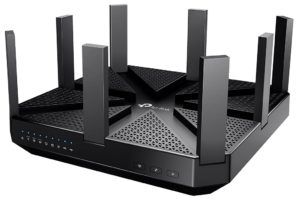
Introduction
We all have a wireless router, and to a certain extent, it’s just that thing that sits in the corner of the house, collecting dust and hopefully going about its business without a lot of involvement on the part of the user. But lately, networking manufacturers have started re-envisioning what a router can be. Is it really just an appliance that you set and forget, or can it be more? That’s the question at the heart of TP-Link’s release of its new HomeCare suite of family protection and control for existing high-end routers. Can a “simple” firmware release really transform an existing Internet appliance into something you actually want to engage with on a daily basis as a tool for improving your Internet experience?
With this context in mind, we were excited to get our hands on TP-Link’s proven Archer C5400 router, now upgraded via software with a host of new features. Truth be told, the deck is stacked in TP-Link’s favor here, because we’ve already reviewed its Deco M5 Whole-Home WiFi system (the first TP-Link product to feature the HomeCare suite), and we found it very compelling. The C5400, however, is a true enthusiast-class product, and while it’s less expensive than the Deco M5, it’s also aimed at those seeking all-out performance. Do features that make one product more compelling necessarily translate to improving an entire product line? We’ll soon see!
Special thanks to TP-Link for providing a review sample of the TP-Link Archer C5400 with HomeCare.
Description and Features
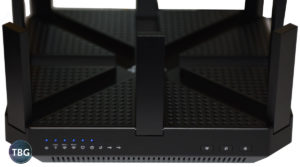
As with most high-end routers, the C5400 looks like something from a Star Trek episode. It certainly isn’t subtle in its presentation, nor is it small (it’s 9″ by 9″). Is it the most attractive router you’ll find? No, it really isn’t, but it’s not the ugliest one either. Our biggest disappointment regarding the styling was that the C5400 really can’t be stood on end, unlike other models that have antennas only on the back and sides. TP-Link in fact has put a number of useful activity lights on the front, as well as three control switches, so it’s clearly thinking users are going to keep that side accessible. We actually appreciate that turning on and off the radio, the WPS feature, and the lighting can be done right from the front panel, rather than having to reach around the back, or worse, dig into the web-based control panel. We also have a hunch that spreading out the antennas as TP-Link has done here might improve performance, which it claims in its marketing material, and may well be backed up by our benchmarks on the next page!
There’s still plenty to find on the back panel, namely the four gigabit ports, the WAN port, a USB 3.0 port, a USB 2.0 port, and the power button. While this is a minor point, some of TP-Link’s competitors are equipping their ultra-high-end routers with eight gigabit ports, but we don’t think anyone will be disappointed in having just four here.
The C5400’s massive proportions speak to the power within, and indeed, with a dual-core 1.4GHz processor, three co-processors, dual 2166Mbps 802.11ac radios, a single 1000Mbps 802.11n radio,
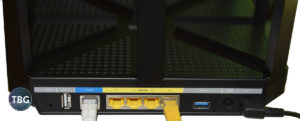
In lieu of a manual, TP-Link offers a quickstart guide in the box. This is becoming a more common practice in the industry, so we weren’t at all surprised, but we are a bit concerned that our sample had no mention of HomeCare in the guide, nor even on front the box. We’re hoping that TP-Link plans to update its packaging with this major new features upgrade, as many users may miss out on it entirely without some discussion of the features outside of online guides. Thankfully, the manual does mention the TP-Link Tether app, but again, the fact that it now serves as the central control point for HomeCare means that TP-Link really should provide a bit more encouragement to users to download it.
Indeed, TP-Link Tether has undergone a huge upgrade to enable the full HomeCare suite, including parental control and virus protection built into the new system update. The antivirus and malware detection is provided by Trend Micro, and a 3-year subscription is included with the C5400 (it’s not clear how this will be handled for existing owners, but we’ll update this article if we get a response from TP-Link). The service currently costs $120/year, so obviously, some users may not wish to continue with it after the included coverage terminates. That being said, it makes a lot of sense to move this functionality out of individual devices and into the router controlling all Internet traffic, especially given that many devices, like IP cameras and thermostats don’t have any inherent ablity to protect against intrusion. As for the parental control suite, it is quite robust, and no doubt has the potential to change the way parents think about how their children use the Internet. Here’s a compliation of four screenshots that illustrate some of the features:
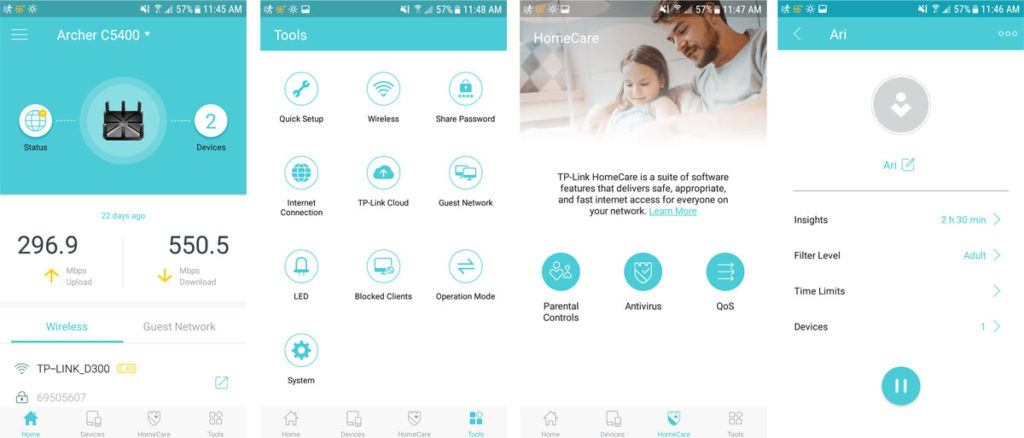
Parents have the ability to pause the internet for individual users (specifically, any devices assigned to them), as well as to set pre-determined times when Internet service is cut off on a daily basis, either at specified times, or after specified durations. For Internet-savvy but easily-distracted children, these features will most definitely be life savers for parents! Our only concern is that these are device-specific, which works for a smart phone, tablet, or one child’s game console, but really doesn’t do much at all to control the home PC, an Internet-connected TV, or a game console used by everyone in the home unless parents are willing to force every member of the family onto the same schedule for these devices.
Also rolled out in this update is Amazon Alexa functionality, and we confirmed that it does indeed work. You’ll need to “enable” the TP-Link skill, which is a process that could be just a bit smoother, but that’s really an Amazon issue, not a TP-Link problem. Once enabled, however, Alexa could perform a variety of tasks, and our favorite was to have it conduct an Internet speed test. We could see this being particularly helpful when slowdowns are occurring in the middle of a streaming movie or online game, and the user wants to confirm whether it’s an Internet issue without having to stop what they’re doing and run a browser-based speedtest. You can have Alexa do other things like turn on the guest network, prioritize a particular use via the QoS feature, or turn off the router’s LEDs. Some of this may be more appealing to do via the app to make sure it’s done right, as the voice commands can be a bit tricky, but it’s still nice that TP-Link offers the Alexa option. Note that IFTTT functionality is also being rolled out with the latest update, but having used IFTTT, we’re convinced it’s only going to be appealing to most tinker-happy users out there, and won’t be a selling point for the average consumer.
Test Setup
Our test setup consisted of an AMD Ryzen-powered PC equipped with the fastest WiFi adapter in our stable, the TP-Link Archer T9E. Being a tri-stream device, it’s actually a step behind the quad-stream C5400, but then again, so is just about every adapter on the market (the only quad-stream model currently being the Asus PCE-AC88) . TP-Link doesn’t even market a quad-stream adapter, so in this chicken-or-the-egg problem, TP-Link is clearly putting its efforts into router development. Most of our benchmarks were collected using Speedtest.net, and thanks to our Gigabit fiber installation, every single wireless networking product on the market is going to be slower than what our connection can provide.
To gauge how the Archer’s performance compares, we brought in the current king-of-the-hill router, the Linksys EA9500 AC5400 Router, which has an MSRP of $400 and currently sells for $348. It’s dominated speed benchmarks not just in our testing, but in testing by various other publications as well. Kings can be overthrown, and as you’ll soon see, TP-Link may have a spoiler on its hands with the enhanced Archer C5400. Consider for a moment that the Archer has an MSRP of $300, and currently sells for $217. We mention MSRPs because it’s quite typical for home networking products to debut at one price, and then drop in price over time. Such is the case with the Linksys EA9500, but even more so with TP-Link’s router. And remember, we’re testing it today because it’s been enhanced with new firmware that adds a host of new functionality at no additional cost.
So, let’s jump into our benchmarks to see how the C5400 performs, and then turn to our conclusion.
Real-World Performance
We’ve tested a lot of routers over the years, but our Linksys EA9500 has played the role of the standard-bearer for quite some time. We’ve never found anything faster, until now…
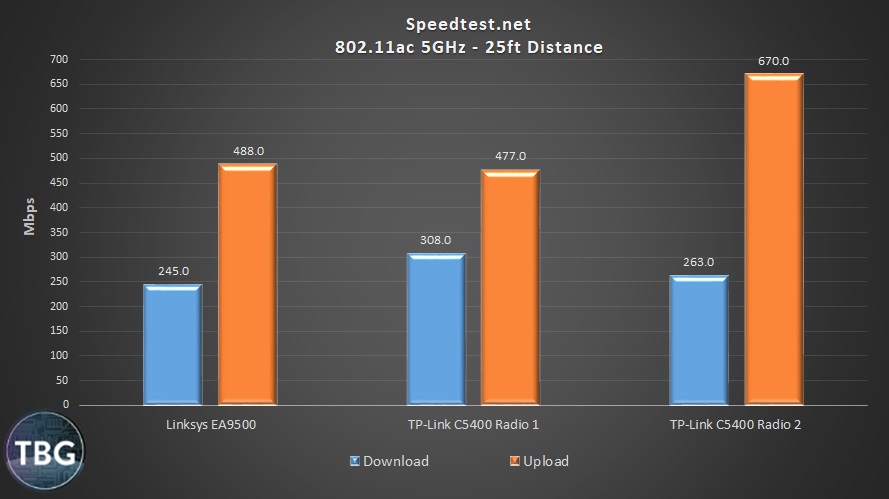
Whoa! The C5400 is way ahead of the Linksys overall. As you can see, however, its two radios do not behave similarly, despite both being rated at quad-stream 2166Mbps. This, by the way, is the same rating as the Linksys, and we wouldn’t be surprised if they share a lot of the same internal circuitry, given how similar their specs are. While the Linksys auto-negotiates the clearest radio for each device, the user must manually connect (and stay connected) to one of the two radios in the TP-Link. They might as well be two separate routers from the point of view of the client device. It’s possible that TP-Link decided on this approach because it performs better, but it may lead to a little confusion among users not knowing how to appropriately utilize the two radios.
Note that in real-world Internet use (as opposed to intranet use), you’ll never see speeds like this, because no servers operate this fast. While our Gigabit fiber can put up some insane theoretical numbers, in our informal testing of downloads via Steam, we got about 31MB/s on the TP-Link and 28MB/s on the Linksys, suggesting that the server is really becoming the bottleneck at a certain point.
Now let’s see if the the C5400 can keep ahead of the competition at a 75-foot distance:
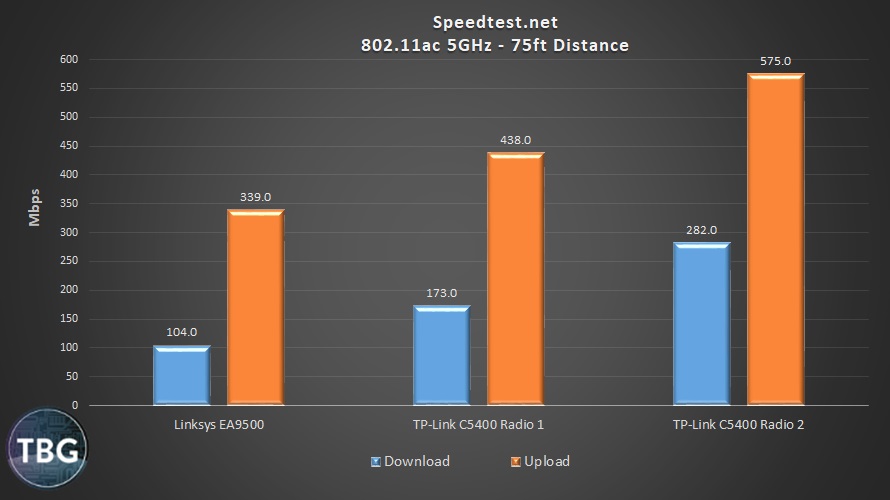
The C5400 didn’t just keep its lead, it extended it. Now both radios are way, way ahead of the EA9500, and in fact Radio 2 is almost three times faster in terms of downloads, and about 50% faster in terms of uploads. We actually started to think that our EA9500 may have degraded over time with 24/7 use (a phenomenon we’ve seen in other long-term samples), but after double-checking some data we collected several years ago using the EA9500, we’re pretty sure it’s actually still performing as it did fresh out of the box. The C5400 is simply superior.
We have one last test to throw at the C5400, and it’s a challenge that has tripped up many a previous competitor….
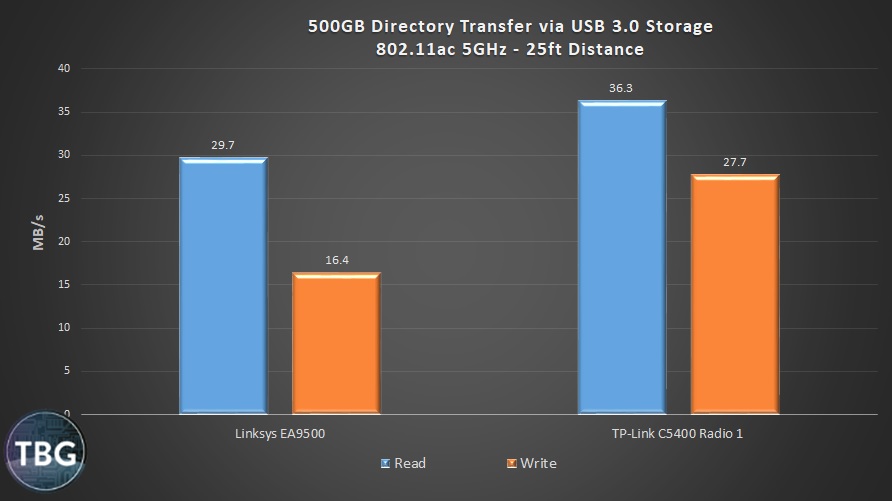
What you see here is our “storage server” benchmark, which tests read and write speed from an external solid-state drive directly attached to the routers via USB 3.0. We thought our Linksys model was pretty impressive, but wow, the TP-Link C5400 just cruises to victory here. It’s a true all-in-one network storage solution. And the best part is that the storage was exceptionally easy to access; unlike what we’ve found with lower-end TP-Link models, you don’t have to jump through hoops to access external drives. Just plug them in, and they’ll be available in the Windows Explorer.
Conclusion
When we accepted TP-Link’s invitation to review the C5400 with HomeCare, we figured we’d have to make excuses for its performance, but that they’d be justified by the enhanced functionality. After having run the router through our benchmarks, we’ve got just one question on our mind: why didn’t we test this thing sooner?!? We’ve always known that TP-Link undercuts the “big names” when it comes to specs per dollar, but we’ve never found TP-Link routers to actually beat the best-of-the-best. Well, that’s what the C5400 just did, and it did so despite a price that matches the competition’s mid-range offerings, and with features that top them all.
The TP-Link Archer C5400 Router is available for $217 as of our publication date, and it picks up a huge recommendation as the ideal high-end router for a busy household. As always, to see our top picks in every category of home networking gear, check out our Networking Buyer’s Guide, updated quarterly!

